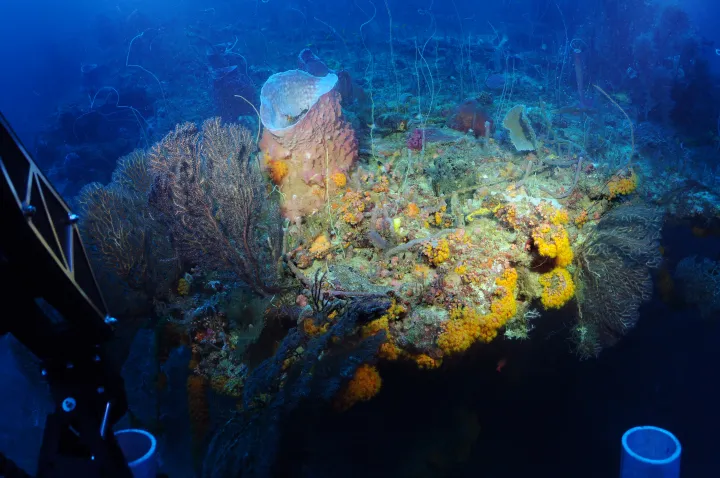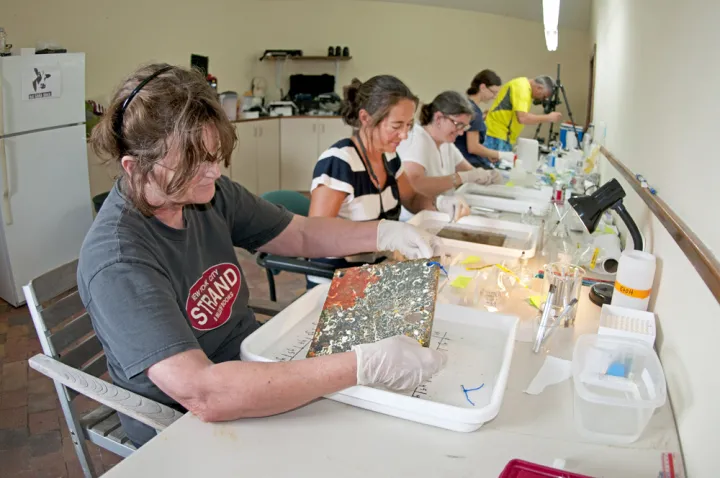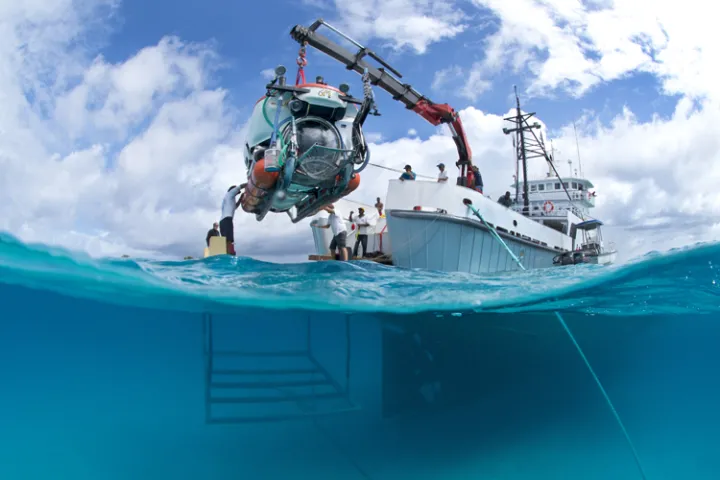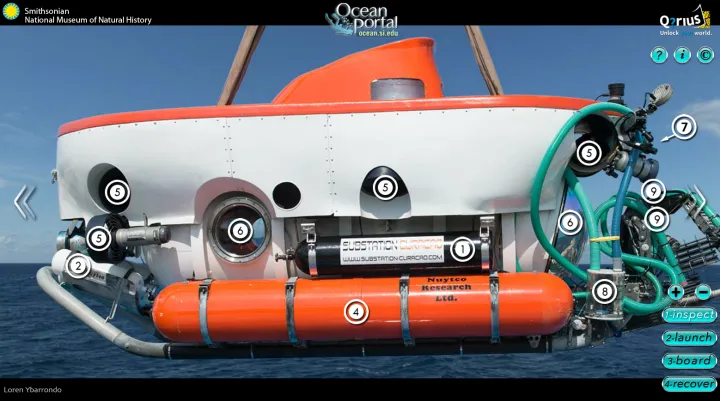
DROP: The Deep Reef Observation Project
Introduction
The Deep Reef Observation Project (DROP) is a Smithsonian research program launched to explore marine life and monitor changes on deep reefs in the southern Caribbean. Found below SCUBA diving depths, deep reefs may represent the most diverse underexplored marine ecosystems in the world.
Shallow water coral reefs are in peril globally, but comparatively little is known about deep reefs, including what role they may play in the survival of shallow reefs above. Diving to 1,000 ft. in a state-of-the-art submersible is allowing Smithsonian marine scientists to visit deep reefs to study and monitor these ecosystems.
Since 2011 DROP has received funding from Smithsonian's Consortium for Understanding and Sustaining a Biodiverse Planet, National Geographic's Committee for Research and Exploration Grant, Prince Albert II of Monaco Foundation, the Smithsonian Tropical Research Institute, the National Museum of Natural History and private donations.
Current Research
Documenting Local Biodiversity
Biological collections with the Curasub off Curaçao have resulted in the discovery of numerous new and rare species of fishes, marine mollusks, echinoderms and crustaceans. This project utilizes the taxonomic expertise of more than a dozen Smithsonian scientists and employs modern molecular tools and digital photography and videography to fully document species and genetic diversity on deep reefs.
All specimens collected are photographed and processed for genetic analyses at Smithsonian Laboratories of Analytical Biology (LAB). Tissue samples are deposited in the museum’s Biorepository, and preserved voucher specimens are permanently housed in the museum’s extensive natural history collections.
Monitoring Changes In Deep Reef Ecosystems
Access to the Curasub submersible provides Smithsonian scientists with the extraordinary opportunity to study tropical-reef ecosystems from zero to 1,000 feet.
Various standardized sampling strategies are being implemented for long-term monitoring of temperature, pH, diversity, and abundance of deep-reef marine life, including the invasive Pacific lionfish. Smithsonian scientists are beginning to investigate how deep-reef communities are partitioned by depth, how environmental conditions change over depth and time, and what role deep reefs may play in the survival of shallow reefs above.
Small structures called ARMS (Autonomous Reef Monitoring Structures) are used on shallow reefs around the world as a standardized way to measure reef diversity. The layers of PVC act as little hotels for settling reef organisms like sponges, tunicates and bryozoans. DROP scientists were able to place ARMS in deeper waters for the first time with the Curasub in 2012 and will continue to retrieve and redeploy these units for years to come. They will compile a multi-year comparative dataset on temperature and biological changes on a vertical reef profile.
Comparative Biodiversity Assessments
Taking deep-reef exploration to other areas in the Caribbean will undoubtedly lead to the discovery of new species and help scientists understand how deep-reef populations and species are distributed geographically.
Most studies of evolution in Caribbean marine organisms are based solely on investigation of shallow-water species, but that’s only part of the reef “picture.” Accurate assessments of Caribbean biodiversity and biogeography will only be obtained by incorporating data from reef ecosystems at all depths in many locations.
Species in a Bottle
DROP has come across some unusual creatures that turn human trash into treasure.
During their submersible dives, researchers found that octopuses sometimes claim discarded bottles as their homes. Once an octopus has claimed a bottle, it will bring in little mollusks to eat. When the bottle gets filled with snail shells, the octopus will move on and find a new home.
“Whenever we see bottles discarded on the bottom of the ocean when we’re in the sub, if they have anything in them, we often pick them up because they’re chock full of little tiny mollusks,” Dr. Carole Baldwin of DROP said.
When DROP picks up the deserted bottles, they find all sorts of interesting creatures. Researchers have described six new genera and ten new species of tiny hermit crabs that have found homes in the snail shells within the bottles. They also described a new species of fish found in a bottle and a new species of brittle star that has only been found living on human trash.
Researchers are now monitoring a few bottles they set up as “octopus traps” to observe how these tiny ecosystems form.
Virtual Sub Dive
The Curasub Submersible
The Curasub is a 5-person manned submersible capable of descending to 1,000 feet. The state-of-the-art sub is equipped with hydraulic collecting arms that allow for the collection of marine life and the deployment of long-term monitoring devices on the deep reef.
Click here to experience what it is like to use a submersible for research. Inspect submersible parts, launch the sub, and dive in to see how Smithsonian scientists explore diverse deep coral reef communities.
Dive in!
Additional Resources
BLOGS
DROP Blogs: Follow our "Summer in a Sub" and “Science with a Sub” blog series to learn more about Smithsonian marine research, unique deep reef species, and challenges of collecting with a submersible.
- A Voyage of Discovery to Inner Space
- On Biodiversity: Discovering its Meaning and Importance
- A Sub and a Sea Toad
- Diving for Crabs in the Deep Sea
- Searching for Cancer Drugs in the Ocean
- Uncovering Biodiversity Before it Disappears
- Ocean Trash: Marine Debris from Shore to Sea
Invertebrate Zoology No Bones Blog: “Charro” and “Cowboy” Hermit Crabs
Invertebrate Zoology No Bones Blog: Yo, Ho, Ho and a Bottle of Shells
Coral Reef Photo Blog - Follow the blog of avid underwater photographer Barry B. Brown. He has spent years documenting life above and below water in Curacao. His blog is continually updated with stunning images of organisms collected with the submersible and other marine life found in shallower waters.
IN THE NEWS
ScienceDaily: A lucky catch: A tiny new fish, Haptoclinus dropi, from the southern Caribbean
Washington Post: Deep reef ‘twilight zones’ slowly yield their secrets to explorers, by Brian Vastag
National Geographic Weekend Radio interview with Boyd Matson. DROP Principal Investigator Dr. Carole Baldwin talks about the discovery of new fish species found off the coast of Curaçao with the Curasub submersible.
Smithsonian Scientists Find New Goby Species In Caribbean Deep Reefs, FishSens Magazine
MEDIA
History Channel: Ocean as Lab Series - In this Ocean as Lab video, Dr. Carole Baldwin talks about exploring deep-reef ecosystems. Knowing what lives in these underexplored areas and understanding how it is changing over time may be critical to preserving tropical coral reef ecosystems worldwide. This video and other Ocean as Lab videos can be seen in the Sant Ocean Hall at the National Museum of Natural History in Washington, D.C.
EOL Curacao Deep Reef Collection - Visit our virtual collection on the Encyclopedia of Life (EOL) to see some of the beautiful and unique species collected by our scientists in Curaçao.
RELATED LINKS
Smithsonian Consortium for Understanding and Sustaining a Biodiverse Planet website





